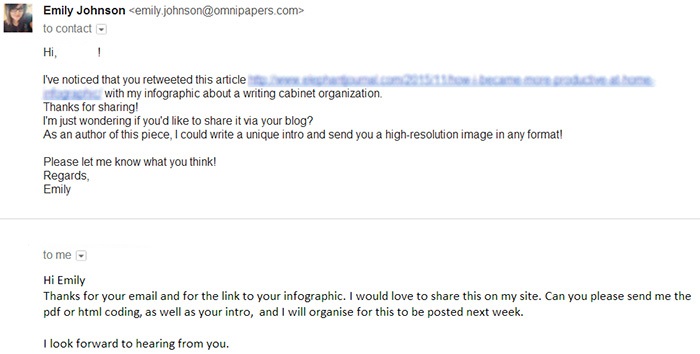“Reading Roundup: What’s New in Blogging Lately?” plus 2 more | |
- Reading Roundup: What’s New in Blogging Lately?
- Tips on Building and Maintaining a Great Relationship with Readers
- Case Study: How One Trick Can Help You Gain 200+ Links from Badass Sites
| Reading Roundup: What’s New in Blogging Lately? Posted: 29 Apr 2016 06:00 AM PDT It’s a rainy and cool weekend here in Melbourne, and I’m looking forward to reading something inspirational with several (ok many several) cups of tea. These have been an excellent start! How Facebook Decides Who Sees Your Updates | EdgarOh. Wow. This was interesting and confusing and a complete rollercoaster of emotion. Now, if you’re like most bloggers, you’ll have set up your Facebook page to share your stuff. One of the tips shared in this article from the people at Facebook is… “avoid promotion”. Yay. Ah but all hope is not losst – they have other pretty solid tips to help you lift your Facebook algorithm game. I wrote them down in all caps. 5 Secrets of Selling to a Small Blog Audience | Be a Better BloggerNot all of us are rolling in millions of unique pageviews a month, but we still have an audience. I think these are pretty solid ideas to help you make the most of what you do have – and I loved her take on small blogs and advertising. How to Make Money When Your Blog is Brand New | Blog TyrantA fantastic and very practical guide to earning an income right from the start. Couldn’t agree more! Five Steps to Measuring Your Social Media ROI | Advertising AgeThis can be an interesting exercise to see if the effort you’re putting in actually is benefiting you. Sometimes it’s not the best strategy to just throw stuff out there and see if it sticks when your efforts could be put to better use elsewhere. The ADHD Guide to Building a Writing Habit | Goins, WriterI don’t know about you, but with the millions of things I have to concentrate on in a day, being consistent with writing falls by the wayside. I’m going to put some of these tips into action. How to Write Subheads That Hook (and Re-Hook!) Your Readers | CopybloggerReally, we know most readers are skimming, and Pamela has a fantastic strategy to keep them on task. 8 Old School SEO Practices That Are No Longer Effective: Whiteboard Friday | MozAre you still doing these? stop! 5 Ways to Improve Your Content Marketing Results Without Breaking the Bank | EntrepreneurBecause we’re not all made of cash, but effective content marketing can certainly help us make some. Video Consumption on Snapchat More Than Doubled in Less Than a Year | TechCrunchIt’s time! Get on it! 11 Ways to Engage Influencers Before Asking For Something | Jeff BullasAhhhh a bugbear of mine. I get pitches alllllll the time both here and at my personal blog, and 99% of the time they’re awful. We can change this! I hope you found something of use this week, I’d love to hear what’s caught your eye? Did the Facebook thing help? It sure gave me food for thought. Stacey Roberts is the Managing Editor of ProBlogger.net: a writer, blogger, and full-time word nerd balancing it all with being a stay-at-home mum. She writes about all this and more at Veggie Mama. Chat with her on Twitter @veggie_mama, follow on Pinterest for fun and useful tips, peek behind the curtain on Instagram, or be entertained on Facebook. The post Reading Roundup: What’s New in Blogging Lately? appeared first on ProBlogger. |
| Tips on Building and Maintaining a Great Relationship with Readers Posted: 28 Apr 2016 06:00 AM PDT
When it comes to blogging, nothing is more important than your readership – if you're publishing the best content in the world with no-one to read it, you quickly get into a Zen-style conundrum. If a tree falls in the forest and no-one is there to hear it, does its content reach the target audience? Building an honest, beneficial relationship with your readers is therefore one of the most important things you can do as a writer, and something that other blog writers often completely fail to do. Despite how uncommon it is, it's not as hard as they'd lead you to believe. First, you need to understand your audience.What do they need? What do they want from your blog? A good starting point is to say "my blog is for X kind of person who wants to do Y kind of thing”. For example, your blog could be for entrepreneurs who want to expand their customer base. From there, you know you can work towards supplying them with what they want. If you don't know enough about your readership to make those assumptions, change that as soon as possible! While programs like Google Analytics and Clicky can provide some insight into your readers, you'll get the best results by far from qualitative methods like surveys and polls. If you already have a few email list subscribers, now's the time to send them a survey or post up a poll. Your readers are the whole reason your blog exists, so get to know them! Related Reading: ProBlogger Podcast: Two Questions to Ask to Help You Find Readers for Your Blog Second, publish targeted, high-quality content.A relationship with your readers begins with you – and with your blog providing quality content. Simply put, you could be the most personable and charismatic writer imaginable, and it wouldn't do you any good if your content was poor. However, combining that charisma with high-quality, targeted content? That's the winning formula. Make sure to take care over your headlines, since they're the first thing the customer will see, and are valuable for SEO purposes – a good headline can really make or break your post. The headline is a promise that the content must then fulfil, and that is best done using a variety of content types to engage viewers and expand your audience beyond your core readers. Different content forms, if used correctly, can reach people far outside your normal catchment area, as some people who dislike reading blogs may happily listen to podcasts, and vice versa. This content should ideally be released as quickly as your audience can consume it – and as your popularity grows, so will the demand for your work. Encourage discussion in the comments – and respond to them.Asking your readers to contribute and share their thoughts in the comments can be a great way to build a relationship with them, as it turns your blog into more of a conversation, a forum where people are free to share their ideas and experiences and feel included. When someone comments on your post, make sure to thank them and respond to their questions or thoughts. Interact and engage them, and you suddenly the blog is a dialogue, and you are building a relationship with the readers through one-to-one interaction. If you need to stimulate your readers to comment, a simple call for participation or comments at the end of the post should do the job! When talking to your readers in the comments, make sure to stay positive, be as helpful as you can with any question or issue they have – and accept any criticism as gracefully as possible. Internet comments are notorious for their harsh and sometimes unjustified criticism, and writers need to develop a thick skin to deal with it. If you get confrontational or defensive, it can only end badly for you – it makes you look bad, stifles honest discussion, and prevents good relationship building between you and your readership. Build interactions and relationships on other channelsYour blog comments are not the only avenue of conversation with your readers – you can also discuss and interact with them through an email mailing list, on twitter, via a Facebook Page or Instagram account, or on forums like Reddit. Finding the communities that your audience haunts can be a great way to build up a level of familiarity and respect, and is an excellent way not only to maintain a good relationship with your readers, but to find other blogs similar to yours as well. Many of your readers will have blogs of their own, and where it is useful to your audience, it will be worth mentioning or linking to those blogs. Once you've found blogs that fit your niche, working with those authors to build your blogs together and connect across the board can often mean reaching an entirely new reader-base and will allow you the chance to build a relationship with some of your most active readers. Don't be afraid to jump in and become part of the community – at the end of the day, that's how really great relationships are made! Dan Goss is the editor and chief content writer for Customer Service Guru, a UK-based site working on improving customer relations, customer experience and business practices the world over. When he isn't writing, he can be found at your nearest coffee machine. The post Tips on Building and Maintaining a Great Relationship with Readers appeared first on ProBlogger. |
| Case Study: How One Trick Can Help You Gain 200+ Links from Badass Sites Posted: 27 Apr 2016 06:00 AM PDT This is a guest contribution from Emily Johnson. Do you consider all specifics of your content and audience when it comes to promotion? The thing is, entertaining content and useful content are far from the same. When your niche is popular and loved by millions, you have no problems with content creation and distribution. But what can you do to deal with a not so well-loved niche promotion? How can you build more links to it from A-list blogs with fewer efforts? The trick is, create content which will be useful for the audience that is much broader than yours. Let me explainUseful content is one aimed at solving a problem of your target audience. The more vital the problem and the better solution you have for it, the better result you’ll get from the promotion. Yes, you know it already. But: Aiming to promote a small website on unpopular or controversial fields, you face many challenges at once, including a niche and audience specifics. This case study reveals the details of working with such websites and shares the secrets of distributing their content, gaining links from top blogs, such as HuffPost, Inc., and others. What we had:
What we needed:
And the results we’ve got:
As you see, impossible is nothing. And you can do the same, or even better. How? This case study explains. The IdeaFirst of all, think about a content idea that will be both relevant to your website and able to attract a broader audience. Things to consider:1) Niche. Make sure the content will complement it. (Our case was a writing niche, so we concentrated on writers.) 2) Audience. Try embracing everyone involved with the niche, too. (Our case was the issue of creating a writer-minded post that would be useful for others as well.) 3) Popular content. Search the Web to determine the most liked and shared publications on the topic to understand what content your audience will like. (We used BuzzSumo to find the most shared content on writing, What's Trending to find the latest writing trends, and Open Site Explorer to examine our competitors’ content and see what websites linked to it.) And now, brainstorming begins! Tip: Don’t limit yourself to anything during brainstorming. Collect and write down even the craziest ideas that come to your mind and seem irrelevant first. Always think of alternative categories of users to attract with your information, and take them into account when choosing the final concept of your content. It can be challenging, but… the sky’s the limit. By reference to your research, outline several topics and then choose the one always in-demand. Our case was the issue of workplace organization. Chosen from five writer-minded topics, initially outlined by our team, it provided the data interesting for bloggers, IT managers, internet marketers, freelancers, and all office employees in general. No matter where they worked, office or home, each of them could use the content for productivity boost and organization of their workspace. Bonus tip: Think big! If your website is about writing, it doesn’t mean you can generate content for writers only. Our case is an example of content combining such topics as writing, work, career, freelancing, productivity, and health. But it’s still relevant. The Process of CreationWith a great idea in pocket, consider the following: 1) Content format. Learn what attracts your audience most. (Our case is an infographic with a text to make the content visually attractive.) 2) Small details. Pay attention to them, as they make readers admire and want to share your work. (Our case was details in the infographic such as covers of best-selling books on shelves or a homepage of a world-famous writing project at comp screen.) 3) Performers, aka people who will create content. (Our case was to find a professional designer for the infographic.) And here the problem comes:With strained circumstances, you can’t pay big money to writers and designers. But you still need beautiful content of a high quality. Tip: Don’t ignore international specialists, as they'll often give you the same quality for a lower price. Use Behance to find them. (Our case was a pro designer from Ukraine who created a great infographic for $250 while US designers asked $1,000 for the same work.) Bonus tip: You can use saved money for paid channels of getting traffic. Outreach and PromotionBrian Dean’s Skyscraper Technique would be a good framework here. However, you may want to change it a bit, considering the scope of the method and the specifics of your promoted content. So, how it works when you decide to get links from… Websites and blogsFirst of all, search the Internet and find online publications that either cover your topic or might be interested in sharing your content. MOZ metrics are still significant to consider while choosing trustful donors, so we used MozBar to select the websites with DA of 30+ and structure them for further work. Like this, for instance: With the contact list ready, start writing emails to webmasters and making agreements about publishing. So, if you have strict time frames or just want to shorten your outreach time, try the same technique. Replies will be not long in coming: Tip: Try Alltop to find websites, blogs, and publications that could become your linking donors. Choose a topic, check the best and latest trends, and select webmasters to contact and offer your content. To find latest trends, content, and influencers, you can also try Social Mention or Epic Beat. Bonus tip: Use Email Hunter to find emails of blog hosts, editors, or webmasters to contact. It’s always better to send your outreach to adam@domain.com, not info@domain.com, isn’t it? If you aim to contact a news portal, not a personal blog, then look for an email of its Editor in Chief or editorial team. Social networksDon’t forget about those sharing your content on social media: monitor users who retweet it and offer to share it at their blogs, too. The fact people liked your content is a signal of their interest, so they might want to post something like this at their blogs as well. That’s how it works: Pinterest can help you, too. Find pinboards with a type of content like yours and contact their authors, asking to pin it. Our case was the infographic, and it worked like this: Tip: Webmasters don’t have time to repurpose your content, making it original for their blogs. Don’t hesitate to say you’ll do that for them if needed. c) …bloggers with columns When your content gathered a good deal of shares, it’s time to get links from A-list blogs, such as LifeHack, HuffPost, Inc., About.com, Adweek, and others. To do that, contact bloggers who write columns at these publications. Your step-by-step tactics to do that: Look for authors who could be interested in your content. Examine their writing style. How often do they publish their works? Do they have articles on your topic? Write your first letter, describing your content idea and asking if they would like to have a look at it. Don’t send any links and don’t ask for sharing at once! Otherwise, huge chances are that you won't get any replies at all. When you get a positive reply from the blogger, send your second letter with the link. Don’t send the same outreach letters to all bloggers. They are busy people, so you need different strokes for different folks. Do they like your content? Then it's time to suggest them to share it with readers. It's the way you can get the link from HuffingtonPost (like we did): And Inc.: Pitfall: Even if a blogger with the column at a badass website agrees to mention you in the post, there are no guarantees moderators will approve it. Plus, they can delete your link from the post. It’s the reason why only a few agree to do that. But it’s not the reason to give up. As experience confirms, impossible is nothing. Tip: Only 15-20% of outreach letters get replies. To understand whether receivers open and read your emails at all, use the instruments for working with inboxes, such as MailTrack or Yesware. They will let you see if and when a receiver opened your letter, or if he clicked the link in it. If your email stays unread for a week, big chances are it went to spam. Don’t hesitate to send a reminder: 50% of them gets replies, as a rule. Bonus tip: The best days to send emails are Tuesday, Wednesday, and Thursday. Monday is a day of full inboxes after weekends: your email can get lost there. Friday is when people relax before a weekend: they can decide to check it on Monday and forget about it. Final Thoughts You might read many case studies from big fish who could spend big money on content research and creation. Their advice is sage and practical, but would it work for you if your website is new, small, or not a brand so far? Impossible is nothing. Everything you need is Richard Branson’s principle of “Screw It, Let’s Do It!” The moral is, the combination of useful content and reasonable outreach do wonders and bring incredible results even for tiny websites. Like ours. Emily Johnson is a writing strategist at Omnipapers. You can chat with her on Twitter. The post Case Study: How One Trick Can Help You Gain 200+ Links from Badass Sites appeared first on ProBlogger. |
| You are subscribed to email updates from ProBlogger. To stop receiving these emails, you may unsubscribe now. | Email delivery powered by Google |
| Google Inc., 1600 Amphitheatre Parkway, Mountain View, CA 94043, United States | |





 This is a guest contribution from Dan Goss.
This is a guest contribution from Dan Goss.













